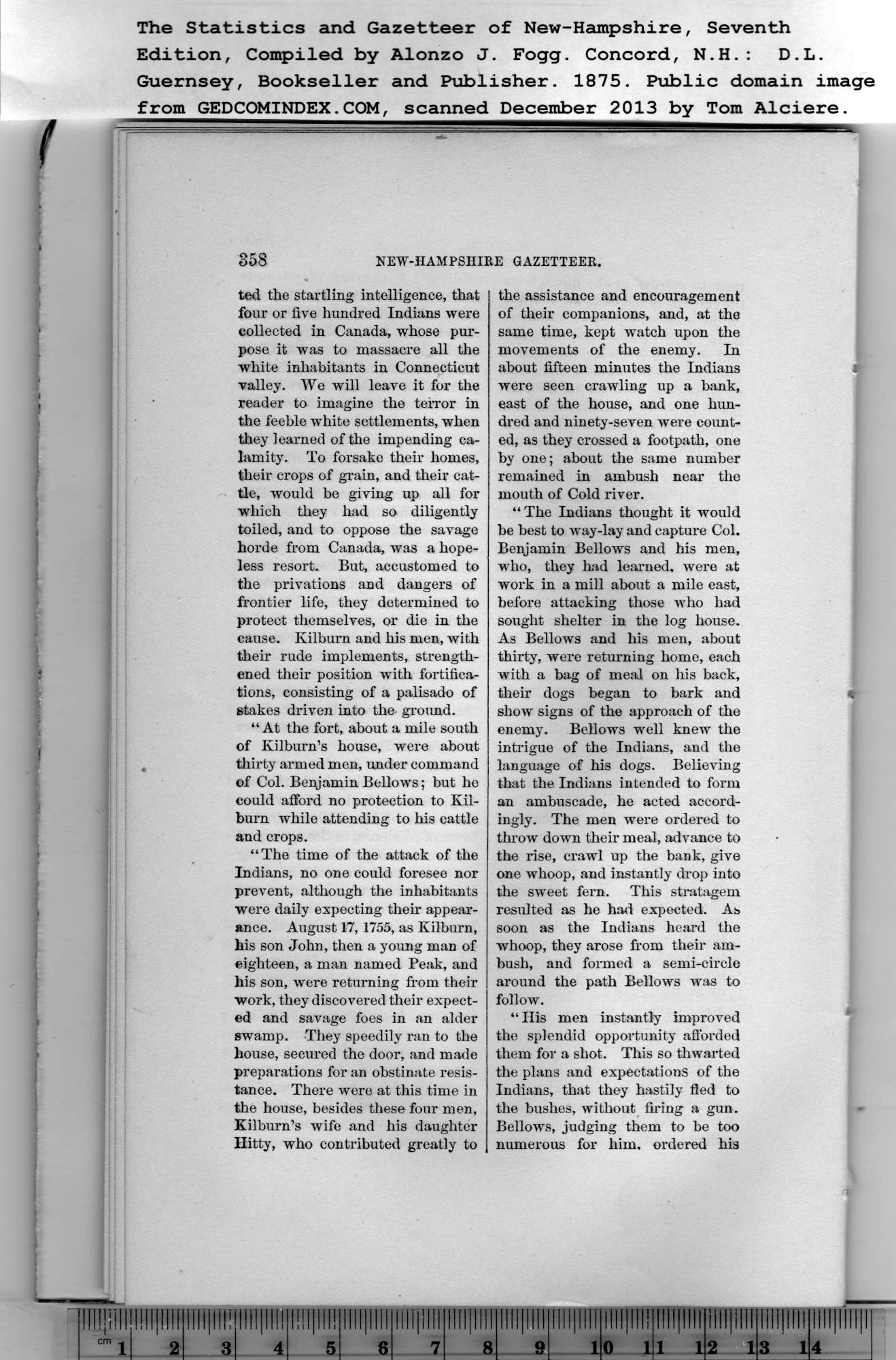|
358
The Statistics and Gazetteer of New-Hampshire, Seventh
Edition, Compiled by Alonzo J. Fogg. Concord, N.H.: D.L.
ted the startling intelligence, that
four or five hundred Indians were
collected in Canada, whose pur-
pose it was to massacre all the
white inhabitants in Connecticut
valley. We will leave it for the
reader to imagine the terror in
the feeble white settlements, when
they learned of the impending ca-
lamity. To forsake their homes,
their crops of grain, and their cat-
tle, would be giving up all for
which they had so diligently
toiled, and to oppose the savage
horde from Canada, was a hope-
less resort. But, accustomed to
the privations and dangers of
frontier life, they determined to
protect themselves, or die in the
cause. Kilburn and his men, with
their rude implements, strength-
ened their position with fortifica-
tions, consisting of a palisado of
stakes driven into the ground.
“At the fort, about a mile south
of Kilburn’s house, were about
thirty armed men, under command
of Col. Benjamin Bellows; but he
could afford no protection to Kil-
burn while attending to his cattle
and crops.
“The time of the attack of the
Indians, no one could foresee nor
prevent, although the inhabitants
were daily expecting their appear-
ance. August 17, 1755, as Kilburn,
his son John, then a young man of
eighteen, a man named Peak, and
his son, were returning from their
work, they discovered their expect-
ed and savage foes in an alder
swamp. They speedily ran to the
house, secured the door, and made
preparations for an obstinate resis-
tance. There were at this time in
the house, besides these four men,
Kilburn’s wife and his daughter
Hitty, who contributed greatly to
the assistance and encouragement
of their companions, and, at the
same time, kept watch upon the
movements of the enemy. In
about fifteen minutes the Indians
were seen crawling up a bank,
east of the house, and one hun-
dred and ninety-seven were count-
ed, as they crossed a footpath, one
by one; about the same number
remained in ambush near the
mouth of Cold river. |
“The Indians thought it would
be best to way-lay and capture Col.
Benjamin Bellows and his men,
who, they had learned, were at
work in a mill about a mile east,
before attacking those who had
sought shelter in the log house.
As Bellows and his men, about
thirty, were returning home, each
with a bag of meal on his back,
their dogs began to bark and
show signs of the approach of the
enemy. Bellows well knew the
intrigue of the Indians, and the
language of his dogs. Believing
that the Indians intended to form
an ambuscade, he acted accord-
ingly. The men were ordered to
throw down their meal, advance to
the rise, crawl up the bank, give
one whoop, and instantly drop into
the sweet fern. This stratagem
resulted as he had expected. As
soon as the Indians heard the
whoop, they arose from their am-
bush, and formed a semi-circle
around the path Bellows was to
follow.
“ His men instantly improved
the splendid opportunity afforded
them for a shot. This so thwarted
the plans and expectations of the
Indians, that they hastily fled to
the bushes, without firing a gun.
Bellows, judging them to be too
numerous for him. ordered his |
